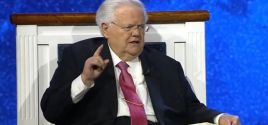U.S. Aid Helps N. Korea Build Nukes, Congress ToldBy Lawrence Morahan, CNS Staff WriterCNS News Oct. 10, 2006 |
Popular 
Report: Blinken Sitting On Staff Recommendations to Sanction Israeli Military Units Linked to Killings or Rapes

America Last: House Bill Provides $26B for Israel, $61B for Ukraine and Zero to Secure U.S. Border

Bari Weiss' Free Speech Martyr Uri Berliner Wants FBI and Police to Spy on Pro-Palestine Activists

'Woke' Google Fires 28 Employees Who Protested Gaza Genocide

John Hagee Cheers Israel-Iran Battle as 'Gog and Magog War,' Will Lobby Congress Not to Deescalate
 CNSNews.com - 17 April, 2000 - North Korea's nuclear production capacity will increase from a dozen nuclear bombs a year to 65 a year by 2010, thanks in large part to American taxpayer money, two renowned U.S. nuclear scientists told congressional leaders last week. North Korea observers have long suspected the communist dictatorship is using Western humanitarian aid to starving North Koreans to feed Kim Jong Il's million-man army. But an aid policy initiated by the Clinton administration in the mid-1990s to finance two light water nuclear reactors in North Korea puts the isolated communist country on the fast track in the manufacture of nuclear weapons, William R. Graham and Victor Gilinsky told members of the House Policy Committee. North Korea's missile proliferation has accelerated dramatically since the Clinton-Gore administration began giving aid to the regime in 1994. "There were no known No-dong missile sales abroad until after the United States signed the so-called Agreed Framework with North Korea," House Speaker Dennis Hastert's North Korea advisory group reported. But since U.S. aid began, the communist state has sold crucial technology to Iran for the Shahab missile that now threatens U.S. forces and their allies in the Middle East, and for a Pakistani missile in 1998 that disrupted the fragile stability of South Asia. In 1994 the Clinton administration signed an agreement with North Korea that was designed to halt North Korea's nuclear weapons development program. North Korea sought light water reactors to provide for their energy needs and the U.S. agreed to provide them in exchange for North Korea giving up its nuclear program. Western aid also earned donor countries the right to inspect the North Korean nuclear facilities. The U.S. believed the plutonium produced would have to be refined before it could be used for weapons grade plutonium, said Chuck Downs, a leading North Korea expert and author of "Over the Line: North Korea's Negotiating Strategy," in an interview with CNSNews.com. But even though the plutonium wasn't the same yield as that used by the U.S. and some NATO countries, it could still be used to make nuclear weapons, he said. For the past six years the United States has been trying to put in place two 1,000-megawatt light water reactors in North Korea. The Clinton administration gambled that construction would take so long that North Korea would collapse politically and economically before the reactors were put in place, Downs said. "As things have turned out, North Korea has received $380 million in aid from various countries last year, $210 million of it from the U.S., and that is enough to satisfy the needs of their regime. So the regime is roaring drunk and not at all collapsing," Downs said. When they are in place in 2010, the light water reactors will give the North Koreans 490 kilograms of plutonium every year, allowing them to build 60 to 100 nuclear weapons a year. "The kinds of facilities that existed in 1994 could only have produced two bombs a year and the kind they conceived [before U.S. aid] a dozen a year," Downs said. Nuclear critics say it is impossible to decouple the risks from the benefits of nuclear power, or the ability of countries that have nuclear power to manufacture nuclear weapons. Ted Taylor, a nuclear scientist and critic of U.S. nuclear policy, told CNSNews.com that all of the world's 450-odd nuclear power plants automatically make plutonium as a side product. "So there's a huge amount of plutonium, which is the stuff from which nuclear weapons are made or can be made, spreading worldwide without adequate safeguards against criminals, terrorists, or governments that are disobeying rules." Taylor, an architect for decades of the U.S. nuclear program, including the program at Los Alamos, was a member of a presidential commission to investigate the nuclear accident at Three Mile Island in 1979. "Nuclear energy is a major activity for destructive forces," he said. North Korea Seeks Relations with South Korea Doug Bandow, a senior fellow at the Cato Institute who has written extensively on North Korea, told CNSNews.com that North Korea seemed to be headed in a more moderate direction politically and has indicated this by agreeing to meet with South Korea for the first time in 50 years. "I think everyone accepts the fact that the North Korean nuclear program is in deep freeze at the moment, but the question is if we didn't essentially buy them off, what would be the alternative," Bandow said. "They haven't offered any ... There's reason to be critical but if you're going to be critical you have to come up with an alternative and I haven't seen one yet." But Downs insisted the U.S. should stand firm when dealing with North Korea, especially in view of its known policies of nuclear proliferation to the United States' enemies around the world. "If you're in the mode of giving gifts, then you give them gifts that don't kill you. You don't hand children the gun. We could have gone in and said we'll give them $20 billion worth of hydroelectric dams and solar energy, wind power, whatever they wanted. We could have thrown in a $5 billion distribution system so that this energy could actually be used. Right now they have two light water reactors that will produce 490 kilograms of plutonium but no distribution system, and they have no idea how they're going to distribute that electricity - if indeed that was their intention at all." |



